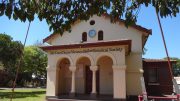Like much of the wider Geelong region the indigenous people of the Wathaurong tribe lived in the area well before European settlement began in the mid 1800’s. The various water holes like Lake Lorne gave fresh water and were great breeding grounds for native birds and animals.

The town of Drysdale was named after Miss Anne Drysdale who with her friend Miss Caroline Newcomb owned large acreages of land in the area. Drysdale moved to the region from Scotland for health reasons and went about farming in the region. The magnificent house she built from stone is named Coriyule in and was built in1849. The homestead still stands today and is believed to be the oldest standing structure. It has recently been put on the market and is privately owned.
Clifton Springs and Portarlington were major ports in the region in the mid 1800’s and Drysdale played an important role in getting cargo to Geelong and beyond with its railway. The railway continued operation until the 1970’s being replaced by truck. Today it is the town’s premier tourist attraction with tourist travel between Drysdale and the Victorian seaside town of Queenscliff.
Drysdale has also been the municipal area of the Bellarine Peninsula, before the amalgamation of all Geelong region councils (except Queenscliff) into the City Of Greater Geelong in the early 1990’s, Drysdale acted as the Shire of Bellarine’s headquarters. Today the headquarters has been transformed into a private school.
Drysdale is home to three historic churches, St Thomas’ Roman Catholic Church was built in and St James’ Anglican Church built in 1871 the lovely Uniting Church in the main strip was built in 1888.
Clifton Springs was once a very popular tourist destination with people flocking to the bayside town for its beautiful mineral springs. Around 1900 the springs were a booming resort. Paddle steamers would bring visitors from near and far to the resort and hotel. By 1923 the steamers had gone and the spring novelty worn off and the resort fell into disrepair before being burnt. It has been rejuvenated today into a country club, community centre and golf course. There are plans to bring the spring water back and save the eroding cliff faces for people to enjoy once again.

The Drysdale area has had a rich history of farming over its 150 years, with potatoes and onions being its specially. In more recent years crops like canola, wine and special breed animals have been successfully grown amongst the beautiful rolling hills.




